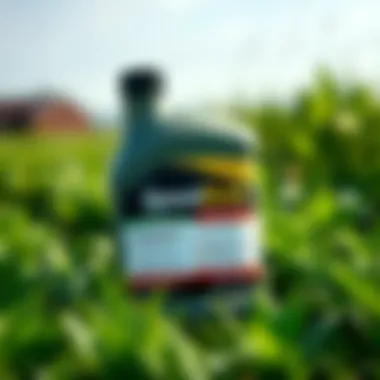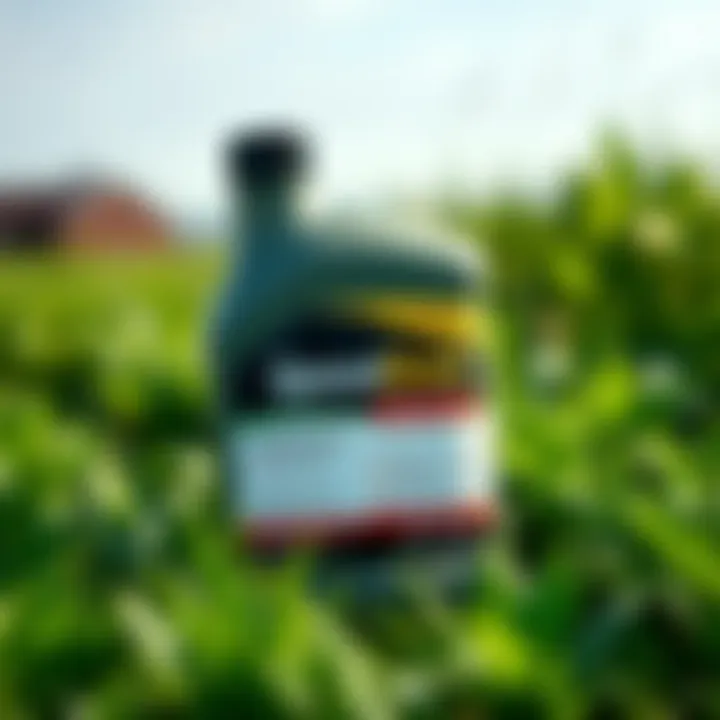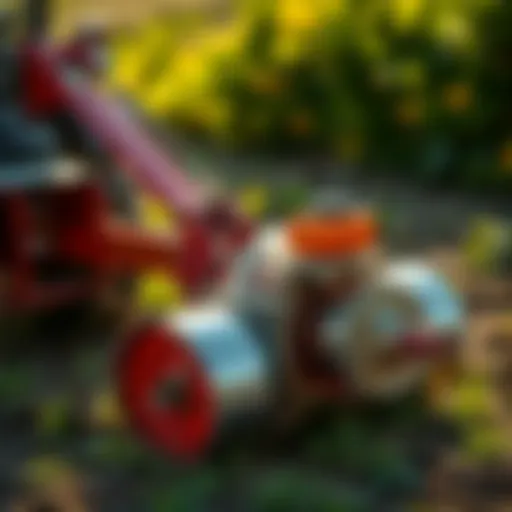Assessing SpeedZone's Effectiveness Against Crabgrass


Intro
When it comes to maintaining a healthy lawn, managing unwanted plant life can often feel like a never-ending battle. One of the more resilient adversaries that homeowners and landscapers face is crabgrass. It tends to pop up uninvited, spreading its roots and ruining the aesthetic of a carefully cultivated landscape. Among the arsenal of tools available, SpeedZone has garnered attention for its selective herbicidal properties.
But, what makes SpeedZone a go-to choice for tackling crabgrass? How does it stack up against other herbicides? This article takes a closer look at these questions, aiming to bring clarity and insight to the realm of weed management.
Understanding the workings of SpeedZone is crucial for those who wish to formulate effective pest management strategies. Are you a professional landscaper? Maybe a gardening enthusiast? You stand to benefit greatly from diving into the nitty-gritty of SpeedZone, from its chemical profile to how to best utilize it in your lawn care routine.
Let's kick off our exploration with an overview of the key concepts and terminology related to SpeedZone and its role in exterminating crabgrass.
Prelims to Crabgrass and Its Impact on Lawns
Crabgrass is not just another weed lurking in the corners of a lawn; it’s a formidable opponent for homeowners and landscapers alike. Understanding crabgrass in the context of lawn care is crucial because of its aggressive growth habits and ability to thrive in various environmental conditions. The presence of crabgrass can compromise the aesthetics of a lawn while leading to potential economic implications tied to its control and elimination. In this article, we delve deeper into these facets, aiming to illuminate the challenges posed by crabgrass and the strategies for effective management, particularly focusing on the herbicide SpeedZone.
Biology of Crabgrass
To grasp the implications of crabgrass on lawns, one must first understand its biology. Crabgrass generally germinates in late spring to early summer when soil temperatures reach around 55°F to 60°F. It's a warm-season annual that spreads both by seed and vegetative means, creating a dense mat of foliage that can quickly invade desirable grass species. The plant’s life cycle can be broken down into three stages: seed germination, vegetative growth, and seed production. These stages of growth occur rapidly, with the potential to produce thousands of seeds in a single growing season, thereby exacerbating its spread. Moreover, crabgrass can outcompete more desirable turfgrass species for nutrients, water, and sunlight, depriving them of the essentials needed to flourish.
Economic and Aesthetic Implications
The economic and aesthetic impacts of crabgrass can be considerable. Lawns overtaken by crabgrass often lose their visual appeal, becoming patchy and brown as the unwanted grass outcompetes desirable turf. For those in the business of landscaping, a crabgrass-infested lawn can lead to dissatisfied clients and potential loss of revenue.
Some of the direct costs associated with crabgrass control include:
- Herbicides and Labor: Regular purchases of herbicides and the labor required for application can add up quickly.
- Soil Amendments: Infestations may necessitate soil treatments to bolster desirable grass species, incurring further costs.
- Increased Water Demand: Crabgrass has a high water consumption rate, which can lead to increased irrigation costs.
In contrast, a lawn that is effectively managed, free from crabgrass, commands a premium in both aesthetic value and overall health. Grass species that are properly maintained not only bloom beautifully but also provide better erosion control and a suitable habitat for beneficial organisms.
"The battle against crabgrass is one that can be won through informed strategies, and a commitment to understanding its biology is key to success."
In summary, evaluating the challenges posed by crabgrass is essential for any homeowner or landscaping professional. The next sections will explore specific strategies for controlling this invasive weed, of which SpeedZone is a significant contender.
Overview of SpeedZone Herbicide
In the realm of lawn care, SpeedZone has carved out a notable reputation as a selective herbicide effective against various types of invasive weeds, particularly crabgrass. Understanding its properties and functionality is essential for anyone contemplating its use in maintaining a robust, lush lawn. This section delves into the chemical makeup of SpeedZone and how it operates at a biological level, providing a thorough grounding for understanding its efficacy.
Chemical Composition
SpeedZone's effectiveness lies in its intricate blend of active ingredients. Central to its formulation are three potent herbicides: carfentrazone-ethyl, pendimethalin, and 2,4-D. Each component plays a crucial role in achieving desired outcomes in weed management:
- Carfentrazone-ethyl: Primarily targets the weed's ability to grow by disrupting photosynthesis. This chemical halts the metabolic processes that are vital for crabgrass and similar species.
- Pendimethalin: Works as a pre-emergent herbicide, creating a barrier in the soil that prevents crabgrass from sprouting.
- 2,4-D: A well-known systemic herbicide, 2,4-D tackles existing weeds by mimicking plant hormones, leading to uncontrolled growth and eventual death of the unwelcome plant.
The careful balance of these ingredients in SpeedZone exemplifies the importance of chemistry in modern horticulture, giving users a targeted approach to weed management. This combination allows SpeedZone to address crabgrass effectively while minimizing collateral damage to desirable grass species. Such specificity is favorable not only for lawn aesthetics but also for the overall health of the ecosystem surrounding the garden.
Mechanism of Action
Understanding how SpeedZone operates is vital for maximizing its benefits. The herbicide functions via a multi-faceted mechanism:
- Pre-emergent Control: The pendimethalin component prevents seed germination by establishing a barrier in the top layer of soil, allowing for proactive management of crabgrass before it even becomes visible.
- Post-emergent Action: Once crabgrass has appeared, the carfentrazone-ethyl and 2,4-D come into play. Both ingredients disrupt the normal physiological processes within the weed, leading to discolored foliage and impaired growth, eventually causing crabgrass to die back.
- Selective Targeting: Importantly, SpeedZone's formulation allows it to selectively target crabgrass while sparing most common turf grasses. This selectivity is pivotal for lawn care enthusiasts who wish to maintain a healthy lawn without sacrificing aesthetics.
In addition, SpeedZone operates effectively over a range of temperatures and environmental conditions, making it a versatile choice for a variety of climates.
Through these mechanisms, SpeedZone not only eradicates crabgrass but also minimizes disruptions to the overall ecosystem in the lawn. When applied properly, the herbicide can ensure that gardens remain verdant and inviting, ultimately supporting sustainable gardening practices.
"Effective weed management is not just about what you apply, but how well you understand the nature of the weeds you’re combating."
This knowledge sets the stage for informed application and strategic decision-making in lawn care.
Comparative Analysis of Herbicides
When it comes to managing crabgrass in lawns, understanding the comparative effectiveness of various herbicides is essential. Evaluating different products not only helps determine the best choice for controlling this invasive weed but also influences future lawn care practices. The landscape of herbicides is broad, with numerous options available, and each has its own set of characteristics and effects on both the target weeds and the surrounding ecosystem. This section dives into the nuances of SpeedZone in relation to its traditional and organic counterparts.
SpeedZone vs. Traditional Herbicides
SpeedZone stands out when put side by side with more traditional herbicides like 2,4-D or triclopyr. Traditional herbicides often rely on broad-spectrum applications, meaning they can affect a wide range of plants—not just crabgrass. This can be a double-edged sword; while it may seem efficient for quick fixes, it may also lead to collateral damage in desirable grass and plants.
One significant advantage of SpeedZone is its targeted action. Formulated with specific active ingredients like carfentrazone-ethyl and mecoprop-p, it selectively kills crabgrass while sparing most turf types. Even so, there are considerations to weigh:
- Speed and Efficacy: SpeedZone typically shows results faster than traditional options, making it appealing for homeowners eager to restore their lawns quickly.
- Soil Residue: Unlike prolonged residual effects of some traditional herbicides, SpeedZone often has a reduced impact on soil health, which aligns better with sustainable agricultural practices.
- Resistance Risk: While it's less likely to cause resistance due to its specific targeting compared to broad-spectrum herbicides, improper use can still facilitate resilience in certain crabgrass biotypes.
SpeedZone vs. Organic Alternatives


The debate between using synthetic products like SpeedZone and organic alternatives, such as vinegar or corn gluten meal, tends to stir strong opinions in the gardening community. Organic solutions might sound appealing out of a desire for eco-friendliness and sustainability, yet they often come with limitations in terms of efficacy and long-term outcomes when dealing with established crabgrass.
For example, while vinegar (acetic acid) can indeed eliminate crabgrass, it often acts only as a desiccant, meaning it kills the visible parts of the plant without addressing root systems effectively. On the flip side, here are some comparative factors:
- Effectiveness: SpeedZone provides a significantly higher rate of efficacy against established infestations compared to most organic options, which may require multiple applications and can struggle with intense crabgrass growth.
- Environmental Consideration: Organic options are less likely to leave harmful residues, appealing to environmentally responsible practitioners. However, SpeedZone's design allows for less impact on non-target species, contributing to its appeal in balanced lawn care approaches.
- Cost and Labor: Although organic products may initially seem cheaper, their increased need for repeated applications can escalate costs and require more labor, sometimes making SpeedZone a more reasonable long-term investment.
Ultimately, weighing these options requires understanding one’s priorities—whether they lean towards immediate effectiveness with a selective herbicide like SpeedZone or a desire to minimize chemical inputs with organic alternatives. Each has its place, but it's critical to evaluate your specific lawn conditions, expectations, and ecological philosophies when making this choice.
Application Guidelines for SpeedZone
When it comes to tackling crabgrass, adhering to the application guidelines for SpeedZone is paramount. Not only does proper application enhance the herbicide's efficacy, but it also minimizes any potential adverse effects on the surrounding environment. Getting the timing right, understanding the environmental factors, and mastering the application techniques can effectively tip the scales in your favor against those pesky weeds.
Timing and Environmental Considerations
Timing is critical in the battle against crabgrass. The ideal period for applying SpeedZone coincides with the early stages of crabgrass growth, specifically when the weed germinates but is still young. The recommended timing often falls early in the spring when soil temperatures are consistently above 55°F, signaling optimal growth conditions for both crabgrass and the herbicide. Missing this window can result in ineffective treatment and a resurgence of crabgrass as it matures.
However, environmental factors also play a significant role. Consider the weather forecast before application. Rainy or windy conditions can dilute the herbicide, affecting its efficiency. Ideally, it should be applied on a dry day with little to no wind, around the time the lawn is slightly moist. This can help improve the herbicide's adhesion to the leaves, increasing its effectiveness.
Key Timing Considerations:
- Ideal soil temperature for application: 55°F or above.
- Ideal weather: Dry with minimal wind.
- Application window: Early spring, immediately after germination.
Application Techniques
Applying SpeedZone effectively requires attention to detail. Here’s a rundown of techniques to enhance your approach:
- Uniform Coverage: Using a sprayer can help achieve an even coverage across the lawn. Spot treatments may miss some areas, so a methodical method ensures no crabgrass is left unchecked.
- Proper Dilution: Always follow the manufacturer’s mixing instructions to dilute SpeedZone appropriately. Too concentrated a solution can harm your lawn while too diluted may not effectively eliminate crabgrass.
- Avoiding Runoff: Be cautious of overwatering after application. Excess water can lead to runoff, wash the herbicide away from the root zone where it's needed most. Ideally, allow at least 24 hours before watering the lawn, ensuring the herbicide has time to penetrate the plant tissue.
- Use of Protective Gear: Personal safety is just as important as effective application. Wearing gloves and a mask can reduce the risk of any chemical exposure during the application process.
Proper application techniques ensure you make the most out of SpeedZone while protecting your lawn and the environment.
In summary, the effectiveness of SpeedZone in eliminating crabgrass hinges on careful adherence to application guidelines. Taking the time to understand the ideal timing and employing proper techniques not only amplifies the herbicide's performance but also supports sustainable lawn management practices.
For those interested in further reading, consider exploring resources on lawn care management and herbicide safety protocols such as those found on US EPA’s website or University of California's Agriculture and Natural Resources. They can offer valuable insights and guidelines to enhance your lawn care strategy.
Evaluating Efficacy in Crabgrass Control
The conversation surrounding effective crabgrass management often points directly to the means by which we assess the success of tools like SpeedZone. Evaluating the efficacy in crabgrass control is not just a technicality; it's fundamental to ensuring that resources are utilized efficiently in any agricultural practice. When we think about lawn care, the implications of crabgrass control extend beyond aesthetics— into economic viability and environmental stewardship. Farmers and garden enthusiasts alike seek solutions that truly make a difference. Thus, understanding the effectiveness of SpeedZone in tackling crabgrass must encompass short-term results as well as its long-term consequences on soil health.
Short-term Effects
The arrival of crabgrass in lawns can be immediate and glaring, often resembling a green carpet over the intended greenery. When SpeedZone is applied, the immediate results often dictate the satisfaction and trust in the product. Initial effectiveness can be gauged through visible reduction of crabgrass, which tends to wilt and discolor shortly after application. Numerous users have reported that within days, substantial decreases in crabgrass populations are observable—supporting the herbicide’s performance in real-world scenarios.
In terms of user experience, many farmers have pointed out that the speed at which crabgrass wilts is encouraging. This responsiveness allows for quick feedback, essential for gauging whether additional applications may be necessary. Moreover, this rapid action allows for reintegration of new grass species as needed, which lays a foundation for successful lawn restoration. It also significantly reduces the immediate competition for resources, effectively giving desirable grass species a fighting chance to thrive.
"the beauty in a well-kept lawn lies not only in its aesthetics but also in its resilience against invasive species."
Long-term Impact on Soil Health
The long-term impact of using SpeedZone brings forth new conversations related to soil health and ecosystem balance. While its short-term efficacy excites many, we must also take a step back to appraise the consequences of repeated usage. Continuous applications can, in some cases, alter the soil chemistry, potentially affecting microbial communities essential for nutrient cycling. It’s critical that users strike a balance between effective weed management and the maintenance of healthy soil.
Long-term monitoring of treated areas often shows shifts in soil quality—sometimes beneficial and sometimes detrimental. Farmers need to consider that while SpeedZone offers immediate control over crabgrass, activities such as crop rotation or the introduction of cover crops can help mitigate negative soil impacts. Monitoring nutrient levels and organic content over time helps ensure that any benefits gained from crabgrass control do not come at the expense of soil vitality.
Inclusion of periodic soil testing as part of an integrated lawn management program can help catch potential downsides early. It also sets the stage for better decision-making regarding herbicide use in the future. Therefore, while evaluating the efficacy of SpeedZone, it becomes clear that assessments need to incorporate not only effectiveness in eradication but also considerations for maintaining long-term soil health.
Challenges and Limitations
Understanding the challenges and limitations of SpeedZone in crabgrass elimination is crucial for anyone looking to maintain a healthy lawn. Despite its efficacy, using this herbicide doesn't come without its share of hurdles. This section delves into two primary concerns: Resistance Development and Environmental Concerns. Each aspect sheds light on the importance of using SpeedZone responsibly while achieving desired lawn care outcomes.
Resistance Development
One major issue with using any herbicide, including SpeedZone, is the potential for resistance development among weeds. Just like us humans adapt and evolve, so do these resilient plants. When SpeedZone is used repeatedly on crabgrass, it’s possible that some crabgrass plants may begin to develop a tolerance to the herbicide's active ingredients. This scenario leads to a cycle where higher doses of chemicals are required over time, which can further exacerbate the problem.
To mitigate resistance, a few strategies can be employed:
- Rotate Herbicides: (Different active ingredients can help manage and reduce the risk of tolerance.)
- Mix Methods: (Consider using cultural practices or mechanical removal alongside herbicides.)
- Monitor Populations: (Keeping an eye on weed populations can help inform your herbicide strategy.)
The bottom line is that while SpeedZone can be effective, its repeated application without a well-thought-out plan may lead to diminishing returns.
Environmental Concerns
When discussing herbicides, one cannot overlook their potential impact on the environment. SpeedZone, being a synthetic herbicide, raises questions about its effects on non-target organisms in soil and surrounding ecosystems. Applying this herbicide irresponsibly can lead to runoff, which might affect adjacent plants, soil organisms, and even local water sources.


Here are a few environmental considerations to keep in mind when using SpeedZone:
- Soil Health: The chemical components may disrupt beneficial microorganisms in the soil, which play a vital role in nutrient cycling.
- Biodiversity: The herbicide might affect not only crabgrass but also other flora and fauna, leading to a more homogenous ecosystem.
- Water Contamination: Pesticides frequently end up in waterways through runoff and leaching, posing risks to aquatic life.
Understanding these environmental challenges is essential in adopting a sustainable approach to lawn care. Not only does it promote healthier ecosystems, but it also aligns with the growing emphasis on environmental stewardship in agriculture.
"Consider the long-term impacts of your lawn management choices; a thriving ecosystem benefits both plants and people."
Striking the right balance between effective crabgrass management and ecological responsibility is key in lawn management. By incorporating diverse approaches and understanding the limitations of herbicides like SpeedZone, one can achieve a more sustainable lawn care routine.
Sustainable Practices in Lawn Management
In the modern context of environmental awareness, sustainable practices in lawn management have become not just a preference but a necessity. The importance of maintaining a lawn that is both thriving and eco-friendly lies at the crossroads of agriculture and environmental stewardship. A well-managed lawn can significantly contribute to biodiversity, improve air quality, and combat soil erosion.
One of the critical elements of sustainable lawn care is the optimization of resource usage. This includes water conservation, using organic fertilizers when possible, and reducing reliance on chemical weed killers. Notably, the long-term benefits of employing sustainable lawn management practices extend beyond aesthetic appeal. For one thing, they harness natural processes to control pests and promote healthy growth, leading to a resilient ecosystem that can withstand the pressures of crabgrass and other weeds.
Environmentally conscious lawn maintenance strategies can:
- Enhance soil structure: Rich soil provides a robust foundation for grass and plants, allowing them to grow vigorously.
- Reduce chemical runoff: Lessening the use of synthetic chemicals significantly minimizes pollution in nearby streams, lakes, and groundwater.
- Encourage beneficial insects: Practices such as planting diverse species can attract pollinators and natural pest predators, which helps keep pest populations in check.
The consideration of sustainable practices isn't just about following current trends; it’s about adopting a long-term mindset in lawn care. With the rising costs of synthetic fertilizers and herbicides, many people are seeking alternatives that are healthy for their green spaces and the environment.
"Sustainability is the ability to endure in a relatively ongoing way across various domains of life." - Walter R. Stahel
Implementing these practices may involve shifts in how one views lawn management. Instead of a battle against nature, many are beginning to see it as a partnership. For example, incorporating native plants not only requires less maintenance but also creates habitats for local wildlife. This brings richness into the urban setting, allowing nature to intermingle with human habitation.
The shift toward sustainable practices also includes educational components for homeowners and lawn care professionals. Workshops and informational sessions about alternative techniques and materials are becoming more prevalent. Resources like USDA.gov and EPA.gov offer insightful guidance, while community programs can foster local engagement with sustainable practices.
By interlacing sustainability with lawn care strategies, the focus remains on holistic management, integrating natural systems into conventional practices. Each step taken toward sustainability can contribute toward a greener future—one that benefits not only lawns but the broader ecosystem as a whole.
Integrated Pest Management (IPM) Strategies
Integrated Pest Management (IPM) is a holistic approach to controlling pests that focuses on long-term prevention and balance within the ecosystem. Rather than mere eradication, IPM seeks to control crabgrass populations while minimizing environmental impact and promoting overall lawn health.
Some effective strategies within IPM involve:
- Regular Monitoring: Keep an eye on lawn conditions and pest activity. Identifying crabgrass early can lead to more effective management.
- Cultural Practices: Adjusting mowing heights and watering schedules can discourage crabgrass growth. Healthy grasses can outcompete it when given the chance.
- Biological Controls: Introducing natural predatory insects or using beneficial nematodes can help manage pest populations effectively, without resorting to harsh chemicals.
- Chemical Controls as a Last Resort: If all else fails, targeted use of herbicides like SpeedZone can be part of the management strategy. However, the focus remains on understanding the problem and using chemicals judiciously.
By employing an IPM approach, lawn enthusiasts and professional gardeners can navigate the delicate balance between managing crabgrass and maintaining a healthy, vibrant lawn. IPM emphasizes prevention, monitoring, and response—ultimately proving to create resilient landscapes that thrive in the long run.
Case Studies and Field Trials
The importance of case studies and field trials in evaluating the efficacy of SpeedZone cannot be overstated. These practical applications serve as vital real-world tests to determine how well the herbicide performs against crabgrass, which is a notorious lawn pest. Such studies not only highlight the herbicide's effectiveness but also provide insights into best practices for application, potential pitfalls, and overall implications for lawn management.
When assessing a product like SpeedZone, it’s essential to rely on evidence gathered in diverse settings. Field trials conducted across various geographies and lawn types can elucidate the herbicide’s capability under differing environmental conditions. This helps both professionals and enthusiasts understand how temperature fluctuations, humidity levels, and soil types may influence the effectiveness of SpeedZone in controlling crabgrass.
Success Stories
There have been notable success stories arising from field trials involving SpeedZone, which underscore the herbicide's potential. One particularly compelling case was documented in a suburban community with a heavy crabgrass infestation. In this trial, SpeedZone was applied during the peak growth season of crabgrass. Within weeks, the once vibrant crabgrass patches began to yellow and die off, allowing the healthy grass beneath to flourish. Gardening enthusiasts in the area reported a remarkable turnaround, with lawns achieving new levels of beauty.
In another instance, a local golf course faced an ongoing battle against crabgrass, which threatened its reputation. After implementing a SpeedZone treatment regimen, the groundskeeping team measured a significant decrease in crabgrass population over just two application cycles. Not only did the visual quality improve, but the overall turf health benefitted from the herbicide's targeted action. Words from a course manager summed it up:
"The difference was like night and day. With SpeedZone, we finally got the upper hand on that pesky crabgrass."
Such stories highlight the herbicide’s role in transforming lawns from overrun to outstanding, showcasing its capabilities as more than just a product, but a tool for positive change in lawn management practices.
Lessons Learned from Trials
Field trials yield invaluable lessons which extend beyond the successes. One notable lesson from these studies is the significance of timing in application. Many trials emphasized that applying SpeedZone when crabgrass is small and actively growing leads to better results. This insight informs lawn care professionals regarding the optimal window for application, highlighting the importance of understanding local environmental cues and crabgrass growth patterns.
Moreover, some trials indicated that while SpeedZone works effectively, in certain situations, it might not be enough on its own. For example, in situations where crabgrass populations are particularly dense, combining SpeedZone with other integrated pest management strategies enhances overall outcomes. This multi-faceted approach can mitigate resistance development and boost long-term lawn health.
For further reading about the roles of case studies in agriculture, one might consider insights from various horticultural programs available through educational institutions like www.extension.org or www.agriculture.gov.
Expert Opinions and Recommendations
The efficacy of SpeedZone as a selective herbicide brings forth a wellspring of insights from experts in agriculture and horticulture. Experts play a valuable role in shaping the understanding of how SpeedZone can be effectively implemented to tackle crabgrass issues. Their evaluations combine empirical data, field experience, and emerging trends, making their perspectives crucial for effective lawn management.
Importance of Expert Opinions
Expert opinions are often grounded in extensive research and practical applications. They dissect the various components of SpeedZone, explaining how it works and where it shines. Here are some key points to consider:


- Data-Backed Evaluation: Agronomists often base their recommendations on specific studies and trials that have been conducted on SpeedZone, providing solid evidence of its effectiveness.
- Best Practices: They offer insights into how to properly apply SpeedZone, thereby maximizing its benefits while minimizing input costs. This is crucial for anyone wanting to get the most bang for their buck.
- Innovative Approaches: Experts frequently keep tabs on new methodologies and findings, suggesting altered application or complementary strategies. This keeps homeowners and professionals alike on the cutting edge of lawn care.
- Environmental Awareness: They emphasize the need for balance, discussing how to employ SpeedZone responsibly—taking into account local ecosystems and avoiding detrimental impacts on surrounding flora and fauna.
Insights from Agronomists
Insights from agronomists about SpeedZone can be particularly enlightening. They touch upon whether it truly lives up to its claims against crabgrass and underline various considerations:
- Chemical Efficacy: Agronomists highlight that SpeedZone is formulated to specifically target crabgrass while being less harmful to desirable grass species, which can ease the worry of damaging a well-maintained lawn.
- Application Timing: Many experts emphasize that the timing of application significantly influences SpeedZone's effectiveness. They advocate for applying it during the early growing season when crabgrass is most vulnerable.
- Soil Health Concerns: Some agronomists raise flags about potential long-term effects on soil health, urging users to assess soil conditions continuously when using any herbicide, including SpeedZone. So, a lousy application might impact beneficial organisms in the soil.
"Proper understanding and application of herbicides are pivotal for attaining optimal results without compromising environmental integrity."
- Integrated Pest Management (IPM): Agronomists frequently recommend incorporating SpeedZone into a broader Integrated Pest Management strategy. This means actively monitoring lawns for signs of crabgrass and employing SpeedZone as part of a multi-faceted approach using cultural and biological controls.
Future Directions in Crabgrass Control
Understanding the future directions in crabgrass control is immensely important for anyone involved in lawn care and agricultural management. As crabgrass continues to adapt and resist various treatments, staying ahead of these changes is key for effective management. Future directions offer insights not just into the persistence of crabgrass but also into developing more effective methods for controlling it through innovative technologies and strategies that are environmentally responsible.
Innovations in Herbicide Development
The landscape of herbicide development is evolving. As scientific knowledge expands, so too does the ability to create new formulations that target specific weeds like crabgrass while minimizing harm to desirable plants. Innovations in herbicides are driven by several factors:
- Selective Action: New formulations are being designed to selectively eliminate crabgrass without affecting surrounding turf. This is crucial in maintaining the aesthetic quality of lawns while managing invasive species.
- Resistance Management: As weeds adapt to chemicals, it's essential to develop herbicides that are less prone to resistance build-up.
- Biological Solutions: Research into bio-based herbicides is gaining traction. Products derived from natural sources can provide effective control with reduced environmental impact.
- Nanotechnology: Incorporating nanotech into herbicides may enhance their performance, allowing for precise application that maximizes efficacy while reducing runoff and soil contamination.
This innovation in herbicide development isn't just about creating more products; it is about creating smarter solutions that align with sustainable practices.
Role of Technology in Pest Management
Advancements in technology are reshaping how we approach pest management. The role of technology in lawn care can’t be overstated. Here are some pivotal advancements:
- Precision Agriculture Tools: Utilization of drones and GPS technology allows farmers and lawn care professionals to monitor crabgrass infestations with pinpoint accuracy.
- Data Analytics: Analyzing weather patterns, soil conditions, and pest reports can give insights that help in predicting the best times for application of herbicides like SpeedZone.
- Mobile Applications: A growing number of apps provide real-time insight into lawn conditions, alerting users to when pest control measures may be needed.
- Integrated Pest Management (IPM): Technology enhances IPM strategies by combining various control methods into a cohesive plan, integrating mechanical, biological, and chemical tools for more effective pest management.
In summary, the future directions in crabgrass control rely heavily on innovations in herbicide development and technology utilization. By following these paths, not only can efficiency and effectiveness of crabgrass control improve, but we can also aspire towards more sustainable lawn care practices. As the challenges change, so too must our strategies, enforcing an ongoing commitment to research and adaptation.
"The future belongs to those who believe in the beauty of their dreams." - Eleanor Roosevelt
For further reading on trends in agricultural technology and herbicide development, one might consider visiting USDA.gov or the National Pesticide Information Retrieval System.
Additionally, resources like Wikipedia's article on Crabgrass can provide a broader context to the discussion.
The End and Summary of Findings
The examination of SpeedZone as a selective herbicide in the battle against crabgrass reveals pivotal insights for both amateur and professional lawn care aficionados. As crabgrass can dominate a garden and diminish the aesthetic value of lawns, understanding how effective SpeedZone can be in controlling this invasive species is more than just a matter of garden pride; it's also tied to the economic efficiency of turf management. The goal here is to navigate the challenges that crabgrass presents and evaluate how SpeedZone serves as a tool in accomplishing that.
The analysis covered multiple facets—ranging from its chemical properties to the methodologies surrounding application. Each aspect has its significance, collectively painting a comprehensive picture. For instance, the chemical composition allows us to appreciate how SpeedZone precisely targets crabgrass while minimizing collateral damage to desirable plants. Utilizing an appropriately timed application technique again, becomes crucial to its effectiveness.
Key Benefits:
- Efficacy: SpeedZone has shown notable success rates in controlling crabgrass, particularly when applied at the correct growth stage.
- Flexibility: Its adaptability in diverse climate conditions broadens its appeal among users.
- Sustainability: When used judiciously, SpeedZone can fit within a broader Integrated Pest Management strategy without compromising environmental integrity.
Yet, no product is without its considerations. Users should stay informed about potential resistance developments and remain vigilant regarding environmental impacts. This vigilance leads to responsible lawn management, ensuring future applications are effective and sustainable.
"SpeedZone stands as a viable option in the ongoing quest to reclaim lawns from the relentless grip of crabgrass."
In wrapping up this assessment, it’s evident that while SpeedZone offers robust solutions, it’s essential to remain aware of both the advantages and limitations it brings to the table. Future innovations in herbicide technology may further enhance efficacy, ensuring tools like SpeedZone will continually evolve to meet the challenges posed by persistent weeds. Understanding its strengths and potential pitfalls allows users to implement it wisely, ultimately leading to healthier, more beautiful lawns.
References and Further Reading
Understanding the tools and methods available for managing crabgrass is fundamental for anyone engaged in lawn care. This section highlights the importance of referencing and further reading to solidify one’s knowledge in using SpeedZone effectively against crabgrass infestations. As we dive deeper into the vast pool of resources available, one can see how these references serve multiple purposes:
- Operational Guidance: Many sources provide detailed application methodologies that help in maximizing the efficacy of SpeedZone. Whether it's the appropriate rates of application or techniques to ensure optimal soil conditions, literature guides users in practical ways.
- Comparative Insights: Exploring various studies could offer a broad spectrum of viewpoints on the performance of SpeedZone compared to alternatives. This comparative data can facilitate informed decision-making regarding product selection based on specific lawn conditions.
- Scientific Background: A good grasp of the chemical composition and mechanisms of action behind SpeedZone aids in understanding how it interacts with different environmental factors. This knowledge fosters a better appreciation of the herbicide's function and can influence its successful application.
- Case Studies and Real-world Applications: Learning from cases where SpeedZone has been applied successfully—or less successfully—can provide valuable lessons. These experiences shared in broader literature can encourage practitioners to tailor their approaches based on tested results.
- Addressing Sustainability Concerns: In the age of environmental awareness, literature that discusses the sustainable use of herbicides, like SpeedZone, alongside Integrated Pest Management strategies, strengthens the argument for responsibly managing crabgrass while maintaining healthy lawns.
Thus, engaging with credible sources is not just beneficial but essential. They enrich the understanding of best practices and innovative strategies utilized in lawn management. To help guide your exploration, here are some recommended resources:
Recommended Literature
- "Weed Management Handbook" - This comprehensive manual offers a deep dive into effective weed management strategies, including specific sections dedicated to herbicides like SpeedZone.
- "Crabgrass Biology and Control Techniques" - A focused report that outlines the biological aspects of crabgrass and provides practical advice for management.
- USDA Guidelines on Herbicide Use - Official guidelines from the United States Department of Agriculture detailing best practices and legal considerations surrounding herbicide use, including resourceful insights into SpeedZone and its applications.
- Research Articles and Journals - Academic contributions often found in journals focusing on agronomy or horticulture may provide empirical data on SpeedZone and its effects, presenting findings from field trials and experiments.
- Gardening Forums and Community Discussions - Engaging with platforms like Reddit can help gather anecdotal evidence from local users on the performance of SpeedZone in various conditions. Community wisdom often highlights unique challenges and personalized management solutions.
By immersing oneself in these readings, it becomes easier to navigate the complexities of crabgrass management using SpeedZone effectively while aligning with sustainable practices.







